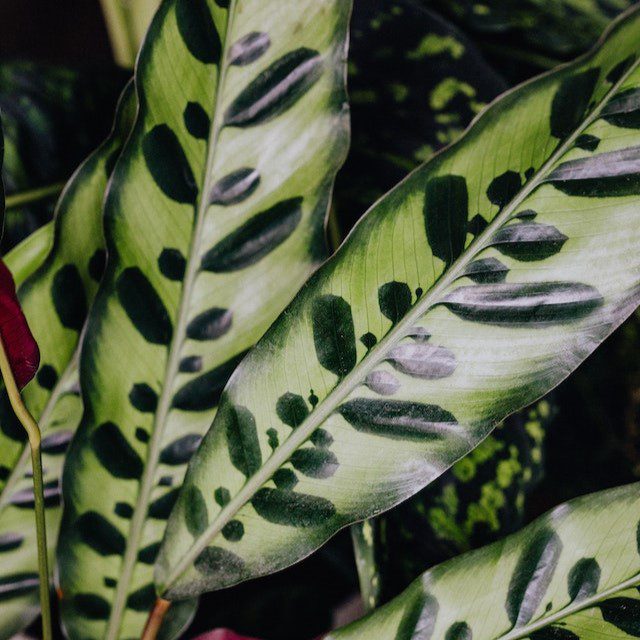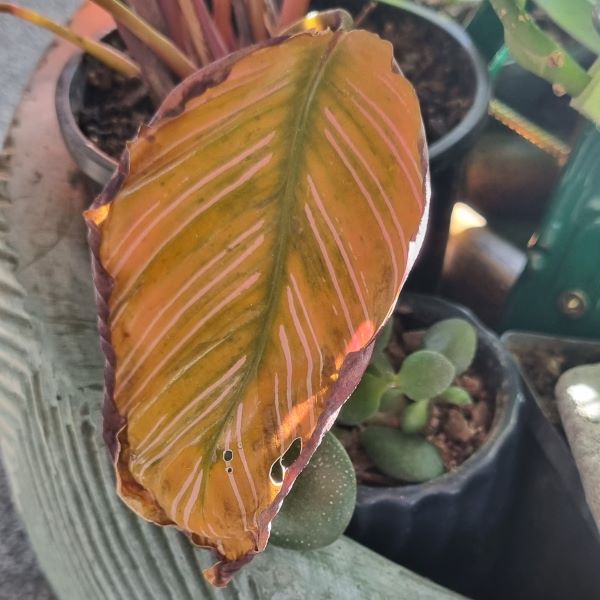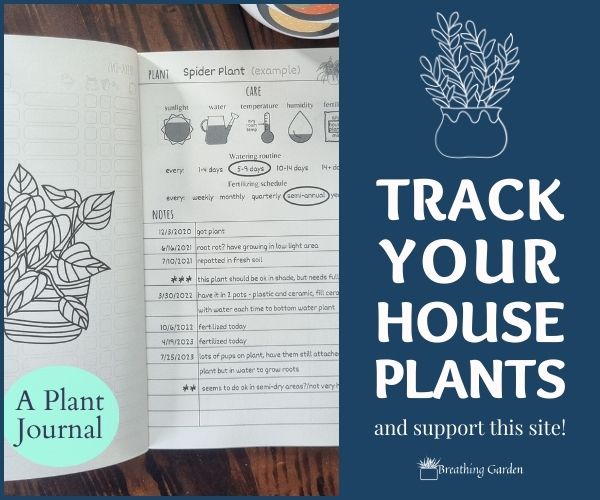Calathea plants have beautiful leaves, making them a very popular choice to try and grow in your home. But a common problem you may notice is your calathea leaves turning brown. This may signify that your plant isn’t getting the attention and care it needs, and can be caused by a variety of factors.
*This post may include affiliate links. When you purchase items from these links, we will receive a small commission, at no extra cost to you, to help support this website. Thank you for your support! Read more ->
Keep reading identify the cause of these brown leaves and get your calathea plant back to it’s normal self with beautiful, striking leaves!
Why Are Your Calathea Leaves Turning Brown?
Calathea, also known as the “prayer plant,” boasts over 60 species with a multitude of bold and colorful leaf patterns. But when you start noticing calathea brown edges or browning leaves, it’s time to do some investigation as to what’s causing this.
The most common causes for these leaves turning brown include underwatering, overwatering, too much sunlight, lack of humidity, and pests.
1. Underwatering
One of the leading causes of your calathea leaves turning brown is underwatering. Calatheas require consistently moist soil, and allowing the soil to fully dry out between waterings can lead to those dreaded brown leaves. These brown leaves will also start to look dry, and may start curling.
To ensure your plant receives enough moisture, water your calathea frequently and adjust the watering schedule based on seasonal changes and the environment.
2. Overwatering
While underwatering can stress your calathea plant, overwatering can be just as harmful! If you notice yellowing leaves with brown edges that almost look like they are rotting, it might be a sign of overwatering.
Excess water can suffocate the plant’s roots, making it challenging for the plant to absorb nutrients. Make sure to check the soil’s moisture before adding water by sticking your finger about an inch deep into the soil. If it feels moist, hold off on watering for a couple of days.
3. Too Much Sunlight – Calathea Brown Leaves
Calatheas are sensitive to direct sunlight, too much light can either bleach the leaves of their beautiful patterns and colors, or burn the leaves, causing them to turn brown.
While light amounts does depend on variety, I’ve found that the Calathea Ornata (the pinstripe plant) prefers bright but indirect light with space to open up. Be sure to keep your calathea plant in a location that receives indirect sunlight or filtered light through a curtain.
It’s essential to ensure that your plant gets enough light, but not too much.

4. Lack Of Humidity Causes Calathea Brown Edges
Calatheas are native to tropical regions, which have high humidity levels. If you live in an area with low humidity, it could be the reason behind your calathea’s brown leaves.
To add moisture to the air, consider using a humidifier near your plant or placing a tray filled with water and pebbles under the pot. Misting your calathea plant with filtered water can also help maintain the required humidity levels.
5. Pests
Pests such as spider mites, aphids, and mealybugs are unwelcome visitors that can leave your calathea leaves with brown edges or spots. To rid your plant of these harmful pests, try wiping the affected leaves with a mixture of water and mild dish soap. Additionally, be mindful of the plant’s cleanliness and remove any fallen debris to prevent new pests from settling in.

If you do notice pests on your plant, also be sure to isolate it from other plants to keep the bugs from spreading!
It may be the case that there are multiple factors causing the calathea leaves turning brown on you! Too much sunlight, underwatering, and low humidity all can go hand in hand together causing issues for your Calathea. And pests thrive in moist conditions, so if you’ve got an overwatered Calathea, you may notice pests also snacking on the leaves.
Read more about how to care for a Calathea Ornata plant.
Removing Brown Leaves and Brown Edges
If you want to remove the brown leaves or edges of leaves on your Calathea plant, you can. There are just a few things to make sure of before you remove any!
Try to not remove too many leaves at once, as taking too many away will cause stress on the plant. However, not removing any of the brown Calathea leaves can also cause stress on the plant. It’s important to find a balance and only remove a few leaves a time. Be sure to use clean scissors or shears when taking leaves off.
You can also just remove Calathea brown edges without taking off the entire leaf. This will allow the healthy part of the leaf to continue growing, and can remove the eye sore for you.
Calathea Leaves Turning Brown: In Summary
If you’re noticing your calathea leaves turning brown, it is a sign to worry about the plant and do some investigating to see what might be the problem. Maybe you’re underwatering or overwatering it, or it’s getting too much sun, not enough humidity, or you’ve got some pesky bugs feasting on it.
Remember, the Calathea genus is picky when it comes to it’s needs, so stay vigilant when checking on this plant! Remember that it is a beautiful plant when all of it’s needs are met. Good luck and happy planting!



